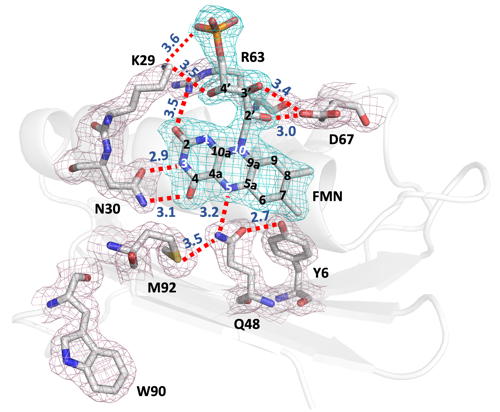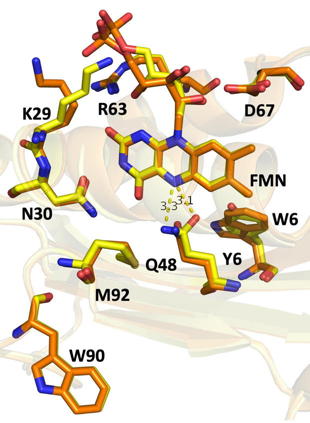Journal:IUCrJ:S2052252524010170
From Proteopedia

Crystal structure of a bacterial photoactivated adenylate cyclase determined at room temperature by serial femtosecond crystallographyKapetanaki SM, Coquelle N, von Stetten D, Byrdin M, Rios-Santacruz R, Bean R, Bielecki J, Boudjelida M, Fekete Z, Grime GW, Han H, Hatton C, Kantamneni S, Kharitonov K, Kim C, Kloos M, Koua FHM, de Diego Martinez I, Melo D, Rane L, Round A, Round E, Sarma A, Schubert R, Schulz J, Sikorski M, Vakili M, Valerio J, Vitas J, de Wijn R, Wrona A, Zala N, Pearson A, Dörner K, Schirò G, Garman EF, Lukács A, Weik M. [1] Molecular Tour In this work, we present the dark-adapted state structures of OaPAC, a recently discovered BLUF (blue-light using flavin adenosine dinucleotide) containing, photoactivated adenylate cyclase from the cyanobacterium Oscillatoria acuminata that uses ATP (adenosine triphosphate) and translates the light signal into the production of cAMP (cyclic adenosine monophosphate). The room temperature structures of the substrate-free OaPAC were obtained for the first time at an XFEL and a synchrotron, and are compared with the cryo-macromolecular structures obtained from data collection from crystals held at around 100 K by us and other researchers. In line with recent observations that SFX (serial femtosecond crystallography) and SSX (serial synchrotron crystallography) measurements can result in data of equivalent quality as seen in the superposition of the BLUE domains of the WT OaPAC SFX structure and WT OaPAC cryo-MX synchrotron structure as well as of the superimposition of the BLUF domains of the WT OaPAC SFX structure (yellow) and WT OaPAC SSX structure. However, comparison of the OaPAC structures with the recently released OaPAC structures of Chretien et al. and the available OaPAC structures of Ohki et al. reveals some interesting features, presumably arising from the different crystallization conditions used. In particular, we observed a significant reorientation of a helix in the ATP binding domain in the crystallization conditions. This reorientation seems to originate from a loop placed on top of the α5 helix which in the preparation appears to push down the α5 helix resulting in the observed conformation of the helix). As a consequence, the ASA (accessible solvent area) for the ATP pocket is reduced from 511 Å2 in the cryo-structure of Chretien et al. (PDB-ID 8qfe) to 315 Å2 in the cryo-structure (PDB-ID 9f1y). This is a significant reduction which results in a close conformation that may prevent ATP from binding. These findings highlight the importance of having an open conformation for ATP binding (PDB-ID 8qfh, ASA: 663 Å2, and the importance of the potential effect of the crystallization conditions. OaPAC, like all BLUF containing photoreceptors rearranges its hydrogen-bond network around the flavin upon blue light illumination, resulting in a characteristic 10 nm red-shift in the main visible absorption band of the flavin with the signaling state decaying back in seconds to the dark-adapted state.
In general, tyrosine 6 plays a key role in the photoactivation mechanism of OaPAC and of BLUF domains, as a PCET (concerted proton-coupled electron transfer) from Y6 which forms the neutral flavin radical takes place. PCET is followed by a recombination of the radical species that results in the hydrogen bond rearrangement around the flavin and transduction of the light signal to the AC domains. To investigate the structural role of this residue, we have replaced Y6 to a tryptophan (Y6W), a mutation which forms a photoinactive enzyme. As anticipated the mutation disturbs the H-bond network</scene> around the flavin, resulting in small changes in the H-bond distances of several residues in the flavin environment with the most extensive change being a ~85° rotation around the CG – CD bond of the Q48 residue, accompanied by a ~20° rotation of the side chain of M92.
Although to a different extent, the observed mutation-induced changes bear a resemblance to the blue light induced changes responsible for the hydrogen bond rearrangement around the flavin in the WT protein. Overall, this study paves the way for time-resolved studies at XFELs (TR-SFX) and synchrotrons (TR-SSX) which will allow a correlation of the available spectroscopic signatures of the substrate-free enzyme with the early-formed structural intermediates, making it possible to obtain a complete picture of the photoactivation mechanism of OaPAC.
References
|
| ||||||||||||||



